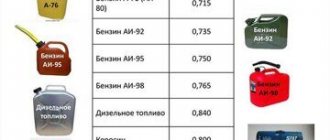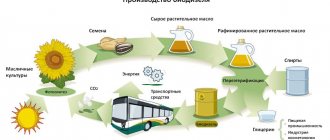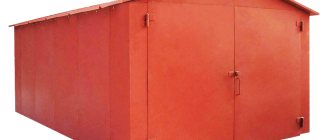When organizing fuel transportation, it is often necessary to convert the mass into liters and vice versa, including during wholesale deliveries from the manufacturing plant. Diesel fuel, like other petroleum products, is purchased in tons. In the future, for personal use, the calculation is carried out in liters. This is precisely what explains the need to transfer from one unit to another. Using the following instructions, you can easily determine how many liters are in a ton of diesel fuel of different brands.
Diesel
Diesel fuel EURO
Price:
from 35.28 ₽
- Density: 0.84
Buy online
How many liters are in 1 kg?
To find out how many liters there are in 1 kilogram, you need to multiply the number of kilograms by the density value. This can be explained using a simple example: how much will 1 liter of water-based paint weigh, having a density of 1.5 kg/l: 1l*1.5 kg/l = 1.5 kg.
Interesting materials:
What percent of the population lives in cities? How many Russians live abroad? How long do roses live in water? How many Russians live in Canada? How many Russians live in Turkey? How many Russians live abroad? How many Russians live outside of Russia? How much does it cost to live in Pattaya now? How much does it cost to move to Canada? How many Tajiks live in Russia?
What does the current fuel density depend on?
The current density of diesel fuel depends on its brand and temperature. You can find out its density at a temperature of 15 or 20 degrees Celsius in the quality certificate.
The higher the temperature of the oil product, the less 1 liter will weigh, and the volume of a kilogram of fuel will increase.
To check whether the density of diesel fuel corresponds to the data specified in the quality passport, you need to take a liter of diesel fuel, weigh it and place it in the temperature environment in which the manufacturer conducted density tests: +150C or +200C. The exact weight of the fuel must be divided by its volume. We get the current density and compare it with the passport data.
Eurocube 1m3, Cubic Tank 1m3 PE Used unwashed wooden pallet
Cubic capacity 1000 liters, New, Used, Eurocube 1m3, Eurocube 1000l., Eurocontainer 1000l, IBC container, UniCUBE container, Eurocube, Plastic barrel 1m3, Cubic capacity, Containers for water, diesel fuel and other liquid and bulk substances.
The Eurocube is made of polyethylene and has a metal sheathing on the outside. There is a drain valve at the bottom of the Eurocube, and the still container is equipped with a filler neck. The still tank has a geometric design that ensures a high degree of loading and a minimum residual content in the tank when emptying. The Eurocube has a galvanized steel frame. The tubular mesh is all-welded, manufactured using special technologies to enhance resistance to external influences. The container has standard dimensions of 1200 x 1000 x 1160 mm. The Eurocube is installed on a metal, wooden or plastic pallet with special stiffeners to withstand high loads. The vat containers are unwashed and unsteamed, all tanks are fully operational and complete. Inside there was a polymer that can be easily washed with ordinary water. On metal, wood or plastic pallets. Filler neck with diameter from 150 mm to 300 mm. Drain valve with a diameter of 50 to 80 mm. Cube weight 60 kg +- 3 kg depending on the pallet.
On-line application
I bought a Eurocube - ready for the season!
offers a wide range of Containers with a volume of 1000 liters or more. The so-called - Cubic capacity 1000 liters, Eurocube, Eurocube 1000 l., Eurocontainer 1000 l, IBC container, UniCUBE container, Plastic barrel 1 m3, Cubic capacity, Water containers, Tank for water, diesel fuel and other liquid and bulk substances. The size of the New and Used Container is 1200x1000x1160 mm +- 2 cm depending on the pallet. The Eurocube is made of high-quality polyethylene with a 6mm wall thickness. The weight of the Eurocube is 60 kg. +- 2 kg. depending on the pallet. Polyethylene containers in a metal crate on metal, wooden or plastic pallets. A cubic capacity of 1 m3 is equipped with a filler neck with a diameter of 150 mm to 500 mm and a drain valve with a diameter of 50 or 80 mm. 1m3 containers are available in transparent standard versions, black and white-matte; in the latter two cases, the containers do not transmit ultraviolet radiation, therefore, the water is less susceptible to blooming.
PRODUCTION HOLIDAYS FROM 09.14.2018 to 09.30.2018.
We bring to your attention the news: Industrial holidays from September 14 to September 30, 2022.
We apologize for the inconvenience caused to you.
We are waiting for you and your applications on October 1, 2022.
HAPPY YEAR 2022.
Promotion when purchasing a Eurocube!
When purchasing any 1000-liter container (except substandard), you can choose a 12-inch adapter for a drain valve as a GIFT !
Options for varieties of adapters from those offered to choose from - in the office of our company!
Congratulations on March 8th!
Congratulations to all women on March 8th!
May women's day never end, may the streams sing in your honor, may the sun smile on you, and may men give you flowers. With the first drop, with the last snowstorm, We congratulate you on the holiday of early spring, we sincerely wish you Joy, happiness, health, love!
Happy New Year 2016
The team of the Construction Bazaar company wishes you a Happy New Year 2016 and Merry Christmas.
She jumps and gallops deftly, And the task is to catch up with her, But this year she will come to us with you herself! The monkey will inevitably solve all our problems, just as quickly and easily as he jumped before! This year will be all right, Life will be sweet jam!
Use of liquefied gas
It’s a little more complicated with liquefied gas. It is widely used:
- in modern industrial production;
- in thermal and electric power engineering;
- as a reserve stock during the period of the most intensive consumption by the population;
- as a replacement for traditional gasoline or diesel fuel for road transport;
- for domestic purposes.
In the household, it is advantageous to use liquefied gas in cylinders for the operation of gas-consuming household appliances, provided there is no centralized supply line.
Main characteristics
- Cetane number.
Cetane is a hydrocarbon contained in diesel fuel, characterized by rapid ignition under the influence of hot compressed air generated in the combustion chamber of a diesel internal combustion engine. The cetane number determines the ignition quality of a diesel engine; it should not be lower than 45 - 50. We can conclude that the higher the cetane number, the faster the fuel will ignite. High-quality diesel fuel has a high paraffin content and a high cetane number.
Oil contains sulfur. The content of sulfur compounds in diesel fuel is strictly regulated. As part of the fight for environmental friendliness of fuel, as well as reducing the wear of internal combustion engine elements, the sulfur content should be reduced to a minimum. However, as the percentage decreases, the lubricating properties of the diesel engine deteriorate, so it is necessary to use special additives. The best performance indicators are considered to be EURO-4 and EURO-5 diesel fuel brands with a sulfur content of up to 0.05%.
Comments, interesting explanations on the question “how many kg does a liter volume weigh” and some additional information on reference data on physical properties.
Quite often in practice we come across situations when we need to find out what the weight of 1 liter of diesel fuel is. Typically, such information is used to convert mass to other volumes, for those containers whose displacement is known in advance: cans (0.5, 1, 2, 3 l), bottles (250 mm, 0.5 ml, 0.75, 1, 1.5, 2, 5 l), glasses (200 ml, 250 ml), canisters (5, 10, 15, 20, 25 l), flasks (0.25, 0.5, 0.75, 0.8, 1 l) buckets (3, 5, 7, 8, 10, 12, 15, 18, 20, 25, 30 l), flasks and cans (3, 5, 10, 22, 25, 30, 40, 45, 50, 51, 200 l), barrels (30, 50, 60, 65, 75, 127, 160, 200, 205, 227, 900 l), tanks, cylinders, tanks (0.8 m3, 25.2, 26, 28.9, 30.24, 32.68, 32.7, 38.5, 38.7, 40, 44.54, 44.8, 4 6 , 46.11, 46.86, 50, 54, 54.4, 54.07, 55.2, 61, 61.17, 62.39, 63.7, 65.2, 73, 73.1, 73.17, 75.5, 62.36, 88.6 m3, 99.2, 101.5 7, 140, 159, 161.5 m3). In principle, even pots and kettles can be estimated by weight if you know how much one liter of diesel fuel weighs. For domestic use and some independent work, the question may be asked differently, when they ask not the weight of 1 liter of diesel fuel, but how much a liter jar (jar) weighs. Usually people are interested in how many grams or kilograms are in a liter jar. Finding such data: how much it weighs on the Internet is not as easy as it seems. The fact is that the generally accepted format for presenting material in any reference books, tables, technical specifications and GOSTs comes down to giving only the density and specific gravity of diesel fuel. In this case, the specified units of measurement are one m3, cubic meter, cubic meter or cubic meter. Less often 1 cm3. And we are interested in how much a liter volume weighs. Which leads to the need for an additional conversion of cubic meters (m3) into liters. This is inconvenient, although it is possible to correctly convert the cubes into the number of liters yourself. Using the ratio: 1 m3 = 1000 l. For the convenience of site visitors, we made our own recalculations and indicated how much one liter of diesel fuel weighs in Table 1. Knowing the weight of 1 liter of diesel fuel, you not only determine the mass of a liter can, but you can also easily calculate how much any other container weighs, for which is known for its displacement. At the same time, you need to understand the undesirability and impossibility of accurate estimates made on the basis of such recalculations for large containers with a significant displacement volume. The fact is that with such calculation methods a large error arises, acceptable only in the sense of an approximate estimate of mass. Therefore, professionals use special tables that indicate how much, for example, a road or rail tank or a barrel weighs. On the other hand, for applied and domestic purposes, for home conditions, the calculation method based on liter volume is quite suitable and can be used in practice. In cases where we need more accurate data, for example: during laboratory research, for conducting examinations, for debugging the production process, setting up equipment, and so on. It is better to determine the weight of 1 liter of diesel fuel experimentally, through weighing on precise scales, using a special technique, rather than using reference, theoretical, tabulated average data on density and its specific gravity.
What you need to know before making calculations
One of the most important indicators of diesel fuel is its density level, i.e. mass to volume ratio.
This proportion may vary depending on the following parameters:
- Fuel type – summer, winter, special arctic;
- Time of year and storage temperature;
- Natural level of moisture evaporation during long-term storage.
If accuracy is not of fundamental importance, then we can limit ourselves to data relating to the established standard for measurements and calculations.
When purchasing, the necessary information can be clarified with the manufacturer or supplier, since each tank released is pre-weighed, and the density level is determined using special equipment.
Features of the conversion of liquefied gases
In modern industry, liquefied gases are used in the following areas:
- at industrial enterprises;
- in the production of heat and electricity;
- as reserve stocks during the cold season when consumed by the population;
- as an alternative fuel for vehicles;
- at home.
At home, liquefied gas cylinders are used if there is no centralized mains connected to the house. In this situation, the temperature of the supplied fuel is not taken into account, but only the volume is determined. In some cases, in some regions, temperature corrections may be applied when calculating volume if the meter is not equipped with an appropriate device for compensating the readings.
The mixture is prepared by liquefying butane with propane in various ratios. It is not economically feasible to use methane. When the ambient temperature rises to room temperature, this mixture expands with such intensity that the manufacture of cylinders requires the use of thick walls or the use of expensive, high-strength materials.
The proportionality of the transition of the volume of a gas mixture during its evaporation from a liquid state depends on the following indicators:
- chemical elements included in the composition;
- temperature characteristics and pressure level;
- molar mass and degree of density.
It is not possible to determine the exact proportional ratio of the mixture in the cylinder, so an approximate value is taken into account. It is assumed that at a room temperature of 20 degrees, considered standard, when one liter of fuel evaporates in a liquefied consistency, about 200 gases will be released.
The calculation is performed using the following formula:
- Vcub – volume indicator in cubic meters;
- Vl – indicated value in liters.
Formula and calculation procedure
The reason for the need to conduct mutual settlements with the supplier with units of measurement in tons is the physical properties of diesel. As a liquid, it is capable of changing its volume under the influence of temperature. To convert from one unit of measurement to another, you do not need to know many different parameters. All you need is density. Its standard indicators are given in GOST 305-2013. It varies for different brands of fuel, which can be summer, interseasonal, winter and arctic. The following values are used for calculations:
- 863.4 kg/m3 – for summer and off-season diesel brands;
- 843.4 kg/m3 – for winter brands;
- 833.5 kg/m3 – for arctic.










